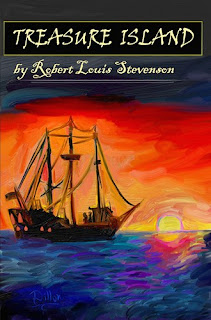Genre: classics/ historical adventure
Pages: around 250 pages, depending on the edition
Published: first published 1883
Review:
I can't honestly say that Treasure Island wasn't exactly what I expected it to be, but that's by no means a bad thing. It is the classic adventure story, beloved by children and adults for over a century. This is the book which more or less gave birth to the modern image of the swashbuckling, peg-legged/one-eyed pirate-- plot-wise, I saw some major fodder for modern pirate films like Cutthroat Island and Pirates of the Caribbean. All in all, Treasure Island is far from a timeless thought-provoker, but it is a classic worth reading all the same.
Our protagonist Jim Hawkins is a young innkeeper's son who is half-fascinated and half-terrified by the little English inn's long-time resident, an intimidating, seafaring drunk who prefers to be known only as "The Captain". Following the Captain's exciting demise and the arrival of a band of loathsome pirates (with various physical disfigurements), Jim chances to find a treasure map hidden away in the dead Captain's chest. Having recruited the game Dr. Livesey and some of his noble friends to sail to this mysterious treasure island, Jim joins the schooner crew as a cabin boy. Enter Long John Silver, one of the most infamous and ambiguous of all literary villains. Silver, a ship's cook who charms both Livesey and Jim, gets together a crew of his sailing buddies to join in on the treasure-hunting adventure. The fabled island is discovered amidst a mutiny at sea and there is a battle for the treasure booty between Jim and Livesey's party and Silver's mutineering ex-pirates.
There are two interesting characters in Treasure Island: Jim Hawkins, our narrator, and Long John Silver. Jim struggles to decide what and who to believe, as the seemingly charming and honest John Silver reassures him time and time again that sticking with Silver is his best chance at surviving the deadly conflicts between the two parties which rage over sea and land. He's a clever, likeable protagonist from humble beginnings, and he's a really great narrator. (Stevenson's writing style is not what you would call old-fashioned, either-- this book is one of the easiest 19th century novels I've ever read). Silver definitely has the reputation of being one of fiction's greatest villains, but I also think he must be one of the most interesting. After years at sea, during which he lost a leg and served as a quartermaster and ship's cook, John Silver has the strange twin reputation of being both a friendly, helpful man and a cunning, brutal one, depending on who one asks. His seemingly morally ambiguous character and his unexpected fate at the novel's end both totally defy villain conventions which are still standard today, and were even more standard in the 1800s when Stevenson wrote Treasure Island.
Treasure Island was not originally published as a novel, surprisingly enough, but as a serial in a children's magazine titled The Mutiny of the Hispaniola. On one level, the book can be considered a pretty typical, if especially exciting, adventure story of the era in the tradition of the ever-popular Robinson Crusoe. Having read it, I think that it must be Stevenson's fantastic prose which has made the novel so immortal in children's literature and literature as a whole, along with the characters of John Silver and Jim. The story itself has as many twists and scallywag characters as your typical Pirates of the Caribbean movie, except that Treasure Island's story actually makes sense and, you know, there aren't any skeletal pirates or vicious, man-eating mermaids hanging around. In the end, this book is by no means a mind-blowing read, but it is fun, influential, and fast-paced classic which is still deserving of its classic status.
Book Rating:




No comments:
Post a Comment